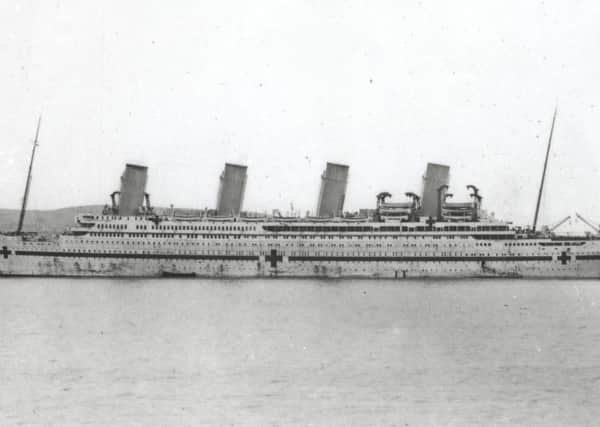Centenary of tragic WWI sinking of Belfast-built hospital ship Britannic


Special commemoration events are being organised and hosted by Titanic Belfast in partnership with the Belfast Titanic Society.
Many people would agree with Roamer that Britannic’s remarkable story is just as epic as Titanic’s, two of three almost identical Belfast-built triplet-ships with the third, Olympic, boasting a long and heroic career as a troop carrier and greatly-loved trans-Atlantic passenger liner.
Advertisement
Hide AdAdvertisement
Hide AdOne hundred years ago during WWI, as casualties at Gallipoli began to mount, the Royal Navy recognized the urgent need to convert passenger vessels into hospital ships.
Commissioned for hospital duties on 8 December 1915, HMHS Britannic, painted white with large red crosses, was commanded by Captain Charles A. Bartlett.
She had over 1,000 beds or ‘cots’ for casualties and on board was a team of around 50 doctors and medics, about 100 nurses, and 330 orderlies.
After bringing many thousands of injured soldiers home, Britannic was released from duty, but the Gallipoli Campaign ended her short respite.
She was recalled and ordered to Mudros.
Advertisement
Hide AdAdvertisement
Hide Ad15-year-old Southampton Boy Scout George Perman was one of 16 Scouts on board, working as messengers and orderlies.
Nurse Violet Jessop, born of Irish parents in Argentina, was one of the young nurses on Britannic.
After five voyages to and from the Mediterranean, Britannic was navigating into the Kea Channel on the morning of 21 November 1916 when there was a large explosion that caused her to shudder violently.
It was first thought to have been a torpedo from a U-Boat that hit Britannic, but it’s more generally accepted today that it was a mine.
Advertisement
Hide AdAdvertisement
Hide AdBritannic listed quickly and sank before Captain Bartlett was able to beach his vessel.
Fortunately, as she was on her way to embark wounded soldiers, there were few on board.
Most of her crew survived, except for 30 who’d taken to the lifeboats which, horrifically, were sucked into Britannic’s fast-spinning propellers.
George Perman and Violet Jessop both survived.
“George was 98 years old when I met him,” maritime historian and owner of Britannic’s wreck Simon Mills told me yesterday.
Advertisement
Hide AdAdvertisement
Hide AdSimon, who’ll be hosting a public question and answer session about Britannic in Belfast on Sunday, has also met Violet Jessop’s niece Margaret Meehan, and Captain Bartlett’s grandson Alasdair Fairbairn.
Mr Mills, who has been researching Britannic’s history since the late 1980s, went down to see the wreck in a submersible in September 1995.
“The submarine was very cramped,” he told Roamer.
The wreck is in 400 feet of water.
“Through a very small porthole Britannic appeared,” he said, “I was looking out on the port side and suddenly - bang! - there she was, bathed in a very ghostly green light.”
The wreck is in remarkably good condition. Unlike Titanic “she’s still in one big piece” Simon explained, “she’s incredibly intact.”
Belfast built them to last!
Advertisement
Hide AdAdvertisement
Hide Ad“The city has more to boast about than Titanic,” Simon added.
I wondered how he ‘took possession’ of such an historic wreck.
“I actually own her,” he told me, “which is unusual to say the least. But I have the UK Government legal title to the wreck.”
He completely understands the sensitivities of owning a wreck where people died though he explained that “it’s not an official war grave” in strict legal terms.
Advertisement
Hide AdAdvertisement
Hide AdHe plans to retrieve selected artefacts from Britannic, and hopes that ‘recreational dives’ can be organised.
“Access to the outside of the wreck has been agreed,” Simon said, “but not inside.”
He’s dedicated to the idea of ‘bringing Britannic home’ - “I would like to see stuff on display in Belfast” he told me, and he’s very positive about his dealings with the powers that be here and in Greece.
“There’s a lot going on at the moment,” he told Roamer “but we’re not talking about raising her from the sea bed,” he stressed.
Advertisement
Hide AdAdvertisement
Hide AdThere are currently discussions ongoing regarding a long term conservation project that will be based in Belfast with part of the collection being housed in Greece.
“One of my favourite items is the ship’s Marconi system” he admitted. “I’d love to see that being retrieved.”
Simon is awaiting the outcome of a lot of high-level discussions here, in London, and in Greece, and is very positive about his plans for the wreck, which include visitors seeing Belfast’s historic ship on the seabed.
“Submersibles are likely,” he told me “there are three or four applications for privately financed submersible visits.”
Advertisement
Hide AdAdvertisement
Hide AdHe added “There’s enough interest in Northern Ireland to say that artefacts will ultimately be on display in Belfast”
There’ll be a talk and a question and answer session with world-renowned Britannic experts including Simon Mills on Sunday 20 November in Titanic Belfast’s Britannic Suite between 2 pm and 3 pm
And Courtesy of the Belfast Titanic Society, some of Britannic’s fittings, including her staircase and railings, will be on show in Titanic Belfast’s Atrium from 3.15pm to 5pm.
On Monday 21 November a commemorative plaque will be unveiled on Titanic Belfast slipways between 8.30 am and 9.30 am, with an exclusive display of records relating to Britannic in the Public Record Office of Northern Ireland between 10 am and 11 am.
Full details are at www.titanicbelfast.com.